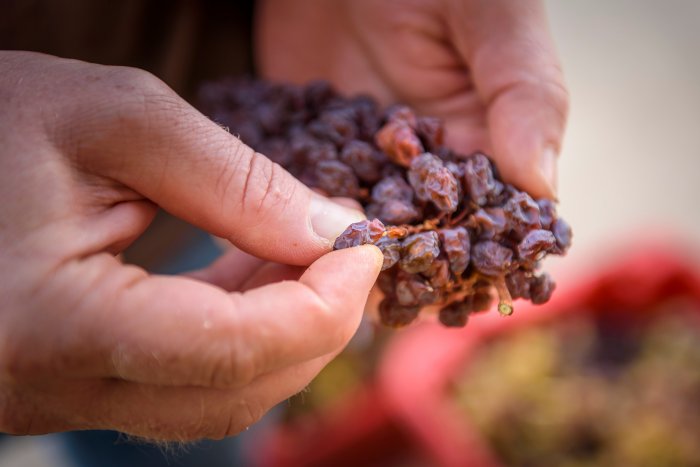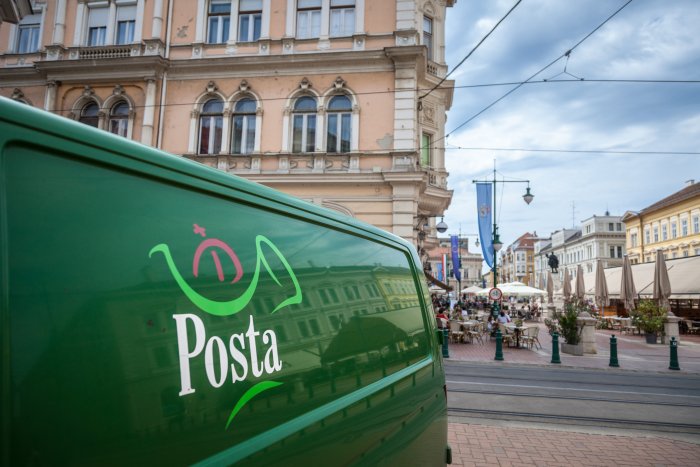Tokaj Wineries a Happy Bunch With This Year’s Vintage

Szilard Csaki/Shutterstock.com
Although Tokaj’s terrific terroir has been progressively turned to making dry wine with increasingly impressive results, the botrytized sweet stuff that is Tokaji Aszú still remains the icing on the Tokaj cake. The 2019 vintage appears to be on its way to becoming a stellar vintage for the region as a whole.
Hands holding a botrytized cluster of furmint grapes during harvest in Mád, in the Tokaj wine region. Photo by Szilard Csaki/Shutterstock.com
Laurent Comas, managing director of Pajzos Tokaj in Sárospatak, said that the 2019 vintage is looking very good for both dry and sweet wine.
“There weren’t any extreme conditions, it wasn’t too warm, nor too dry or rainy,” he said. “If we don’t complain about anything, it means it’s a beautiful vintage.”
He added that the grapes have shown a good sugar content with balanced acidity, both for dry and sweet wines. A bit of rain at the end of September helped trigger botrytis (also known as noble rot), whereby spores of a desired fungus attack the grapes, shriveling them, drawing the water out and greatly increasing the sugar, acidity and flavors in the process, while adding a delicious dried apricot note.
The Indian summer that followed has meant ideal conditions for the slow development of the Aszú berries, which are still being harvested even as we go to print. Wet conditions mean that the noble rot can turn to an unwanted malign grey rot, somethingwhich didn’t happen in this vintage, or at least hadn’t happened by our deadline.
Comas added that it was hoped to bring in all the Aszú berries in by the end of the week, before the fall rains set in. He described 2019 as a better Aszú vintage than 2018, and said 2016 and 2017 were also very good, while Pajzos didn’t have any Aszú at all in 2015.
“It was too rainy [in 2015], from the end of September to the beginning of November, while 2018 was too dry and too hot, although some rain at the end of August helped to make botrytis appear, but it turned out to be more shriveling than pure noble rot.”
Incidentally, Pajzos claimed top stop in Winelovers’ Top 100 Hungarian wines 2019 edition with its 5 Puttonyos Aszú 2006 (HUF 14,060 from Borbazis.hu), a wine that is entering its prime with forest floor and earthy notes now complementing the still very fresh tropical and citrus fruit.
The high acidity cuts through the residual sugar, making the wine delightfully fresh and taut yet layered and complex, too.
Excellent Quality
At the family-owned and run Erzsébet Pince winery in Tokaj, winemaker Miklós Prácser Jr. said the harvest was almost completed, with a large amount of excellent quality Aszú berries having been picked.
“It’s similar to 1999 [a landmark Aszú vintage, sometimes dubbed the vintage of the century], when we could pick a similar amount of top quality grapes. The weather was perfect with lots of sunshine and a bit of rain to kick-start the botrytis,” he said.
When we spoke on October 29, Prácser remarked that it was the first rainy day since the beginning of the month and the grapes were very healthy before then. He added that the dry wines are also good, but that a lot of hand selection had to be carried out due to vinegar rot caused by fruit flies.
“Thankfully, there were only high-quality grapes remaining after selection, which contained good acidity and sugar,” he said.
Erzsébet Pince Lunée 2017’s is a very good example of how well the Sárgamuskotály grape (also known as Muscat Blanc, Muscat Blanc à Petits Grains, Muscat Lunel and Yellow Muscat) can perform in Tokaj as a dry wine.
This French grape is the third most planted type in Tokaj, after the indigenous Furmint and Hárslevelű, and is typically used to add some floral fragrance and exotic fruitiness to Aszú, but the high acidity it can capture in Tokaj, as opposed to many other parts of the wine world where it can taste flat and flabby, can also make it standout towards the drier end of the scale.
This wine was harvested at the end of August, from three different vineyards comprising both loess and volcanic soils, with the former channeling the natural tropical fruit and grapey character of the grape, and the latter bringing more in the way of acidity and structure.
Made totally in the tank to allow the fruity and floral notes to do the talking, it is a bargain at HUF 2,850 from divinoborbar.hu. It also available in the United States from Taste Hungary.
Concentrated and Classy
One of the three vineyards contributing to the aforementioned wine is Zafír, from the commune of Tarcal, with its mix of loess and brown forest soil on bedrock of volcanic dacite. Erzsébet Pince Zafír dűlő 2016 is a complex, concentrated and classy blend of Furmint (90%) and Hárslevelu (10%).
Not everyone is quite as sanguine on the 2019 vintage in Tokaj, however. Erika Rácz from Tokaj Sanzon in Erdőbénye described the vintage as challenging due to hailstones having damaged the skins and made them vulnerable to fungal diseases, which called for rigorous selection on the sorting table.
Zsolt Berger, winemaker at Karádi-Berger, also in Erdőbénye, said that although 2019 was quite a hot vintage with the same level of warmth as 2018, the harvest for dry wine commenced on September 20 this year, three weeks later than in 2018.
With no rain until the end of May, and then a cold June, the grapes got off to a slow start in 2019, with the acidity remaining sufficiently high, enabling them to stay out on the vine into the second half of September to pick up flavor.
Karádi-Berger’s soon-to-be-released Kalandor Furmint 2017 is a great expression of the grape with its often-elusive quince note coming through clear and unimpeded, culminating in a deliciously creamy and round finish.
It shows excellent and measured use of oak from fermenting and ageing in (mainly) used barrels from the Kádár Hungary and Miklóssy cooperages, which don’t block out the grape’s natural characteristics, yet help to build structure.
SUPPORT THE BUDAPEST BUSINESS JOURNAL
Producing journalism that is worthy of the name is a costly business. For 27 years, the publishers, editors and reporters of the Budapest Business Journal have striven to bring you business news that works, information that you can trust, that is factual, accurate and presented without fear or favor.
Newspaper organizations across the globe have struggled to find a business model that allows them to continue to excel, without compromising their ability to perform. Most recently, some have experimented with the idea of involving their most important stakeholders, their readers.
We would like to offer that same opportunity to our readers. We would like to invite you to help us deliver the quality business journalism you require. Hit our Support the BBJ button and you can choose the how much and how often you send us your contributions.







